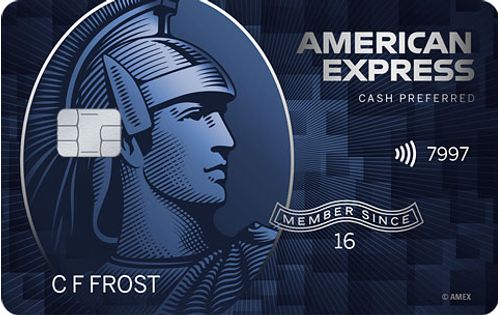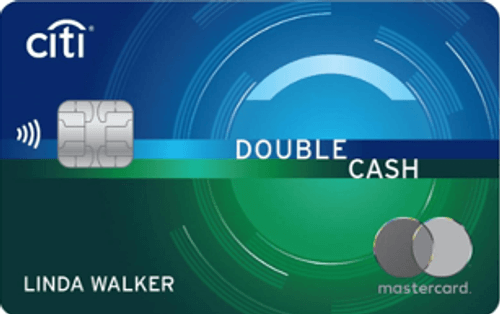Pros
- $0 annual fee
- Good welcome bonus offer
- High rewards rate
Cons
- Spending caps on rewards
- Foreign transaction fee
- Balance transfer fee
Blue Cash Everyday® Card from American Express
Transfer Fee: 3% (min $5)
- Earn 3% cash back at U.S. supermarkets, 3% cash back on U.S. online retail purchases, 3% cash back at U.S. gas stations, on eligible purchases for each category on up to $6,000 per year in purchases (then 1%). Cash back is received in the form of Reward Dollars that can be redeemed as a statement credit and at Amazon.com checkout.
- Terms Apply.
Earn a $200 statement credit after you spend $2,000 in purchases on your new Card within the first 6 months.
Rewards Details
- Earn a $200 statement credit after you spend $2,000 in purchases on your new Card within the first 6 months.
- Earn 3% cash back at U.S. supermarkets, 3% cash back on U.S. online retail purchases, 3% cash back at U.S. gas stations, on eligible purchases for each category on up to $6,000 per year in purchases (then 1%). Cash back is received in the form of Reward Dollars that can be redeemed as a statement credit and at Amazon.com checkout.
- Get up to a $7 monthly statement credit after using your enrolled Blue Cash Everyday® Card for a subscription purchase, including a bundle subscription purchase, at Disneyplus.com, Hulu.com, or Plus.espn.com U.S. websites. Subject to auto-renewal.
- Terms Apply.
Additional Info
- No Annual Fee.
- Enjoy 0% intro APR on purchases and balance transfers for 15 months from the date of account opening. After that, 19.74% to 28.74% variable APR.
- Plan It®: Buy now, pay later with Plan It. Split purchases of $100 or more into equal monthly installments with a fixed fee so you don’t have the pressure of paying all at once. Simply select the purchase in your online account or the American Express® App to see your plan options. Plus, you’ll still earn rewards on purchases the way you usually do.
- Apply with confidence. Know if you're approved for a Card with no impact to your credit score. If you're approved and you choose to accept this Card, your credit score may be impacted.
- More Details & Reviews About Blue Cash Everyday® Card from American Express
Is Amex Blue Cash Everyday Worth It?
The Blue Cash Everyday® Card from American Express is worth considering if you have good credit and you spend a lot on groceries, gas, and online shopping. The card has a $0 annual fee.
What You Need to Do to Make Amex Blue Cash Everyday Worthwhile
Any amount of spending on Amex Blue Cash Everyday can make the card worthwhile, since there’s a $0 annual fee. However, you should strive to spend at least $2,000 in the first 6 months after opening an account in order to earn the card’s $200 statement credit initial bonus.
In addition, you should try to always pay your monthly credit card bill in full. That will prevent costly interest charges from eating away at the value you get from your rewards. The exception to this is during the card’s introductory period.
Amex Blue Cash Everyday offers an intro APR of 0% for 15 months on purchases and 0% for 15 months on balance transfers. This enables you to temporarily carry a balance without accruing interest, as long as you make your monthly minimum payments on time. After the introductory period ends, any remaining balance will be subject to the regular APR of 19.74% - 28.74% (V).
Blue Cash Everyday Review Highlights
-
$200 Initial Bonus
Charging at least $2,000 to this card during the first 6 months that you have it will earn you a $200 statement credit. The credit will be applied to your bill within eight to twelve weeks of meeting the spending threshold.
Many of the market’s premier rewards cards require you to spend double that amount within the same timeframe to earn their initial bonuses. And while they tend to offer a lot more value in absolute terms — $400, for example — Blue Cash Everyday lags a bit behind in terms of initial earning rate. For additional context, the market average for a cash back credit card is $235.
-
1 - 3% Cash Back
The Amex Blue Cash Everyday Card gives 3 times more in rewards than the average cash back credit card in several spending categories. In particular, you’ll earn 3% cash back at U.S. supermarkets, up to $6,000 spent per year – a spending limit most people won’t reach. You’ll also get 3% cash back on gas at any station in the U.S. and on U.S. online retail purchases (up to $6,000 spent per year in each of these categories).
Purchases that don’t qualify for these bonus categories will earn just 1% back – about average for a cash rewards card. That’s important considering that your credit figures to be well above average if you can get approved for Blue Cash Everyday. It’s also important to note that these categories do not change, unlike some cards that switch where you’ll earn at a maximum rate on a quarterly basis.
-
Intro Financing on Purchases and Balance Transfers
Amex Blue Cash Everyday is in the top tier of financing cards, offering intro APRs of 0% for 15 months on new purchases and 0% for 15 months on balance transfers. This head start on interest has the potential to save you hundreds.
For example, you could pay off a $1,500 purchase with 15 monthly payments of $100 each without incurring interest using Amex Blue Cash Everyday. But it would take 18 months and cost around $285 extra to pay off that balance in $100 increments with the average credit card available now, which has an APR of 22.76%.
Just don’t overlook the card’s 3% (min $5) balance transfer fee if you’re interested in paying down existing debt.
-
$0 Annual Fee
Without an annual fee to worry about, you won’t need to spend a certain amount to justify keeping your card open, which enables you to keep your credit history long and your score high.
Blue Cash Everyday Review Lowlights
-
Above-Average Regular APR
You typically need good credit to be eligible for this card, but you probably won’t get a regular APR that reflects such a score. Its regular APR range is 19.74% - 28.74% (V).
The lowest rate you can get from Blue Cash Everyday is reserved for people with the most pristine credit, and it does not compare all that favorably to the average APR among credit card offers for people with excellent credit (17.68%). Similarly, the highest possible option is actually above the 27.48% average for people with fair credit.
This all just goes to show that you should not carry a balance from month to month with your Everyday Card, except responsibly during the first 0% intro APR months.
-
Foreign Transaction Fee
If you ever travel abroad or make purchases through internationally based merchants, there will be some days you’ll have to leave your Everyday Card on the sidelines in light of its foreign transaction fee of 2.7% of each transaction after conversion to US dollars. You may have already anticipated that, however, considering that American Express is not nearly as widely accepted abroad as Mastercard and Visa.
Other Things To Consider About Blue Cash Everyday
-
No Over-Limit Fee
Over-limit fees have largely disappeared in the wake of the CARD Act, which necessitates that you opt in for the ability to spend in excess of your spending limit for an issuer to charge you for doing so. Even if you do opt in, the fee can’t exceed the amount by which you’re over your limit. So this feature of the Blue Cash Everyday® Card from American Express is nice but should not be overvalued.
It's also important to note that the lack of a fee for going over-limit does not guarantee that such transactions will be approved by American Express. Credit card companies approve over-limit transactions at their own discretion and reserve the right not to do so.
-
Cash Back Provided As “Reward Dollars”
Despite the inclusion of the word “Cash” in the card’s name, you technically won’t be earning cash back when you use it. Rather, you’ll earn “reward dollars,” which can be redeemed for a statement credit, at Amazon.com checkout or, from time to time, the likes of gift cards and merchandise. This shouldn’t present any problems, practically speaking, unless American Express ever decides to change the value of a reward dollar. It’s also worth mentioning that there is no minimum redemption amount.
-
Assorted Amex Benefits
Simply being an American Express credit-card customer gets you certain privileges, including “exclusive” entertainment opportunities and a special 24/7 global assistance hotline*. These types of perks are not unique to American Express, though, and how often you’ll actually take advantage of them is probably pretty questionable.
*Eligibility and benefit level varies by card. Terms, conditions and limitations apply. Please visit americanexpress.com/benefitsguide for more details. Card members are responsible for the costs charged by third-party service providers.
Blue Cash Everyday vs. the Competition
annual fee$0 | annual fee$0 intro 1st yr, $95 after | annual fee$0 | annual fee$0 |
Purchase Intro APR0% for 15 months | Purchase Intro APR0% for 12 months | Purchase Intro APRN/A | Purchase Intro APR0% for 15 months |
transfer intro apr0% for 15 months Transfer Fee: 3% (min $5) | transfer intro apr0% for 12 months Transfer Fee: 3% (min $5) | transfer intro apr0% for 18 months Transfer Fee: 3% intro fee ($5 min) for each transfer in first 4 months, after that 5% ($5 min) for each transfer | transfer intro apr0% for 15 months Transfer Fee: 3% for the first 15 months, 4% at a promo APR that Capital One may offer you at any other time |
Regular APR19.74% - 28.74% (V) | Regular APR19.74% - 28.74% (V) | Regular APR17.74% - 27.74% (V) | Regular APR18.99% - 28.99% (V) |
rewards rate
| rewards rate
| rewards rate
| rewards rate
|
bonus offer Earn a $200 statement credit after you spend $2,000 in purchases on your new Card within the first 6 months. | bonus offer Earn a $250 statement credit after you spend $3,000 in eligible purchases on your new Card within the first 6 months. | bonus offer Earn $200 cash back after you spend $1,500 on purchases in the first 6 months of account opening. This bonus offer will be fulfilled as 20,000 ThankYou® Points, which can be redeemed for $200 cash back. | bonus offer LIMITED-TIME OFFER: Earn $300 in welcome bonuses. Enjoy a $100 credit to use towards flights, stays and rental cars booked through Capital One Travel during your first cardholder year. Plus, earn a $200 cash bonus once you spend $500 on purchases within the first 3 months from account opening |
SponsoredApply Now SponsoredApply Now | SponsoredApply Now SponsoredApply Now | SponsoredApply Now SponsoredApply Now | SponsoredApply Now SponsoredApply Now |
Blue Cash Everyday® Card from American Express Review Methodology
This Blue Cash Everyday® Card from American Express review is based on WalletHub’s proprietary 100-point credit card rating system. By using a consistent methodology to evaluate the Blue Cash Everyday® Card from American Express and all other cards, WalletHub’s credit card experts make it easy for people to compare their options and find the best credit cards for their needs.
The WalletHub rating system uses 16 key metrics grouped into seven categories: Fees, Rewards, Two-year Cost, Interest Rates, Approval Requirements, Special Features, and Reviews. Each metric has a maximum number of points allocated to it, based on the metric’s importance as determined by our editors. The points are added up to create an overall rating for the Blue Cash Everyday® Card from American Express out of a maximum of 100 points, which is then converted to a 5-point scale.
Ratings for each category reflect how close Amex Blue Cash Everyday is to WalletHub’s definition of a 5-star credit card, which is based on market conditions and what we believe are reasonable terms. We compare Amex Blue Cash Everyday to that standard to give a numerical approximation of how reasonable and competitive its terms are compared to other cards.
To learn more about how WalletHub rates credit card offers, check out our full credit card review methodology.
Ask the Experts
To help people better understand what the American Express Blue Cash Everyday Card brings to the table, WalletHub posed the following questions to a panel of experts. You can see who they are and read their responses below.
1. Why do you think the American Express Blue Cash Everyday Card limits its bonus rewards rates to purchases made in the U.S.?
2. What do you think is the biggest misconception that people have about American Express credit cards?
3. When do you recommend getting one credit card with good bonus rewards in multiple spending categories (such as the American Express Blue Cash Everyday Card) versus several cards, each with standout rewards in a particular category?
Ask the Experts
Signal Companies’ Professor of Management and Professor of Marketing at the Tuck School of Business, Dartmouth College
Read More
Ph.D., Instructor, Department of marketing, Southeast Missouri State University
Read More
Professor of Marketing, Olin Business School, Washington University in St. Louis
Read More










WalletHub experts are widely quoted. Contact our media team to schedule an interview.